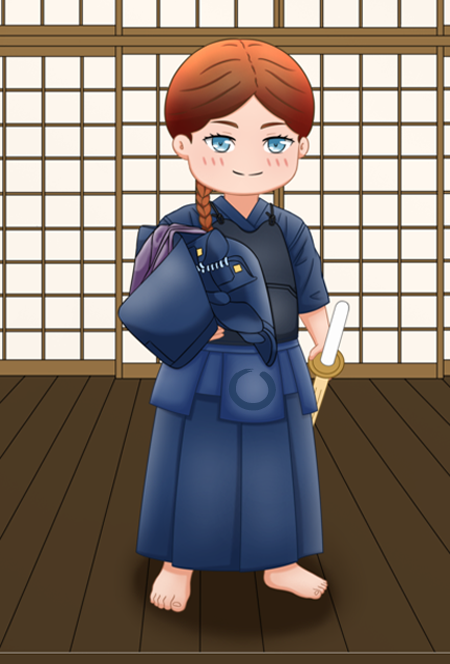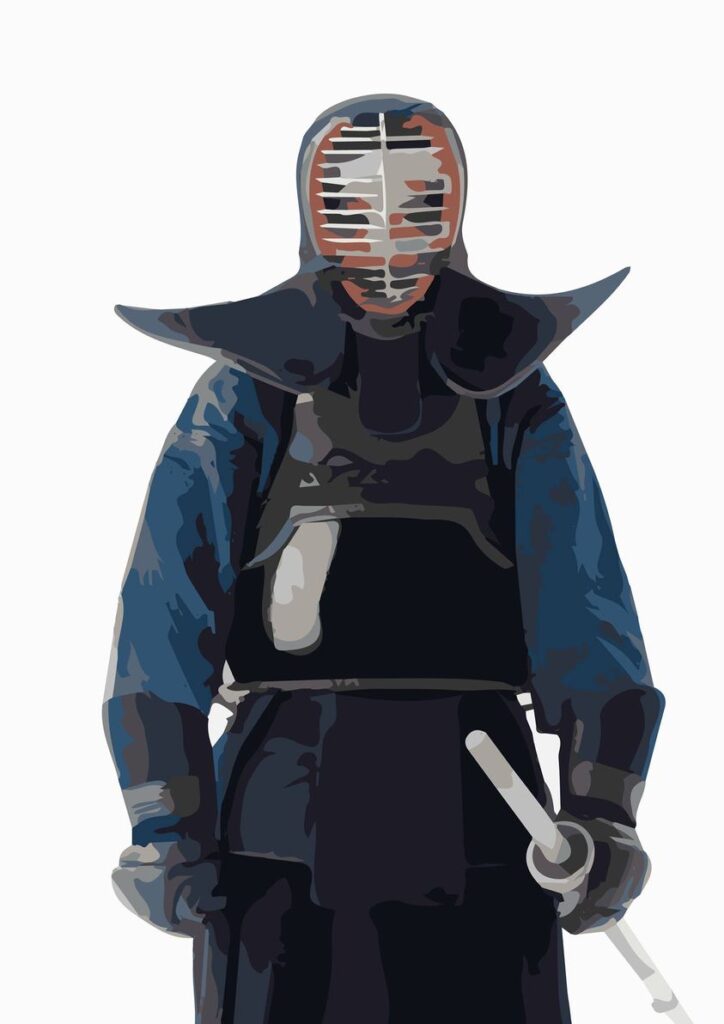In response to the pictures in our Japan Fans Facebook Group, many people asked us what is kendo. Therefore, in her third guest blog, Klara – a Japan Fan from Croatia – will teach us a few things about the history, equipment and purpose of kendo.

Some of the Japan Fans Utrecht practice “kendo” (剣道), every Saturday, at De Middengaarde. In this blog, Klara explains more about this budo.
剣道 Kendo, from 剣 „ken“ – sword 道 „do“ – way, path.
剣道 (Kendo, „the way of the sword“) is a form of Japanese martial art that originated from Kenjutsu (剣術) that uses bamboo swords (竹刀, shinai) as well as protective armor (防具, bōgu). It is a martial art form that requires rigorous physical activity and ultimate skills which require practice inevitably.
History
Swordsmen in Japan established schools of kenjutsu (the ancestor of kendo), which continued for centuries and which form the basis of kendo practice today. The formal kendo exercises known as kata were developed several centuries ago as kenjutsu practice for warriors, they are still studied today, in a modified form.
The introduction of bamboo practice swords (shinai) and armour (bōgu) to sword training is attributed to Naganuma Shirōzaemon Kunisato during the Shotoku Era (1711–1715).
The DNBK (Dai Nippon Butoku Kai – which regulated martial arts at the time) changed the name of the sporting form of swordsmanship, called gekiken, to kendō in 1920.
Kendo (along with other martial arts) was banned in Japan in 1946 by the occupying powers. The DNBK was also disbanded. Kendo was allowed to return to the curriculum in 1950, first as “shinai competition” and then as kendo from 1952.
The All Japan Kendo Federation (AJKF or ZNKR) was founded in 1952, immediately after Japan’s independence was restored and the ban on martial arts in Japan was lifted. It was formed on the principle of kendo not as a martial art but as educational sport, and it has continued to be practiced as such to this day.
The International Kendo Federation (FIK) was founded in April 1970; it is an international federation of national and regional kendo federations and the world governing body for kendo. The FIK is a non-governmental organisation, and its aim is to promote and popularise kendo, iaido and jodo.
The International Martial Arts Federation (IMAF), established in Kyoto 1952, was the first international organisation after WWII to promote the development of martial arts worldwide. Today, IMAF includes kendo as one of the Japanese disciplines.
ABOUT KENDO
Kendoka are the practitioners of kendo, these are the ones who practice this martial art form.
Kendo training is not done in silence. The practitioners of Kendo express their fighting spirit through kiai, a shout. Furthermore, as they make a strike, kendoka strike their feet. Kendo is practiced with bare feet. There are proper dojo (venues) with wooden floors to practise Kendo.
Kendo techniques constitute of thrusts and strikes. Strikes are made on wrists or head and the body is covered with protective armour. Sometimes, a wrong strike can lead to sever injury on the neck. It is therefore essential to practice Kendo often and also follow the rules properly.

Equipment and clothing
The shinai is meant to represent a Japanese sword (katana) and is made up of four bamboo slats, which are held together by leather fittings. A modern variation of a shinai with carbon fiber reinforced resin slats is also used. Shinai have also been used in WWE. Kendōka also use hard wooden swords to practice kata.
The competitors are still protected by the bogu, which consists of;
⦁ (Uwa)gi (jacket)
⦁ Hakama (long divided skirt)
⦁ Do (chest protector)
⦁ Tare (waist protector)
⦁ Men (head piece)
⦁ Kote (padded gloves)
The shinai varies from 43 to 46 inches (110 to 118 cm) in length and usually requires a two-handed grip to be used effectively. Striking attacks can be directed at the head, torso, wrists and forearms, along with thrusting attacks usually aimed at the throat.
However, it is not enough just to hit the target in order to score, the technique must be executed correctly with a strong kiai (shout) demonstrating good spirit and with the use of zanshin (awareness). The winner is decided when one of the fighters reaches two points. More than just a style of fighting, kendo is a way to build character and takes great perseverance, alertness and concentration to master and execute the moves.
A kendo practitioner also needs to conquer his own fears and be able to perform the techniques in any situation. To do this, kendo uses Zen Buddhist meditation in order to learn to gain a mental state known as Mushin (mind without mind). This conscious state of being totally aware but without having a constant flow of thoughts allows for quicker reaction times and usually better and more decisive decision making.
Purpose
⦁ To mold the mind and body
⦁ To cultivate a vigorous spirit
⦁ And through correct and rigid training
⦁ To strive for improvement in the art of Kendo
⦁ To hold in esteem human courtesy and honor
⦁ To associate with others with sincerity
⦁ And to forever pursue the cultivation of oneself
⦁ To love one’s country and society
⦁ To contribute to the development of culture
⦁ And to promote peace and prosperity among all peoples

As the Japan Fans Utrecht wish to form friendship bonds with Japan Fans from all over the world, we are very happy with this third guest blog written by Klara! Klara is a Japan Fan from Croatia who graduated in Japanese Language and Culture from the universities of Pula (Croatia) and Kyoto (Japan).
